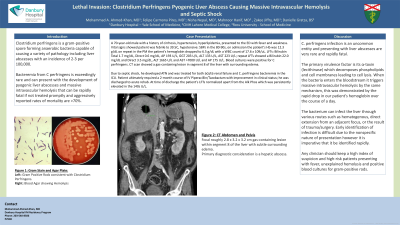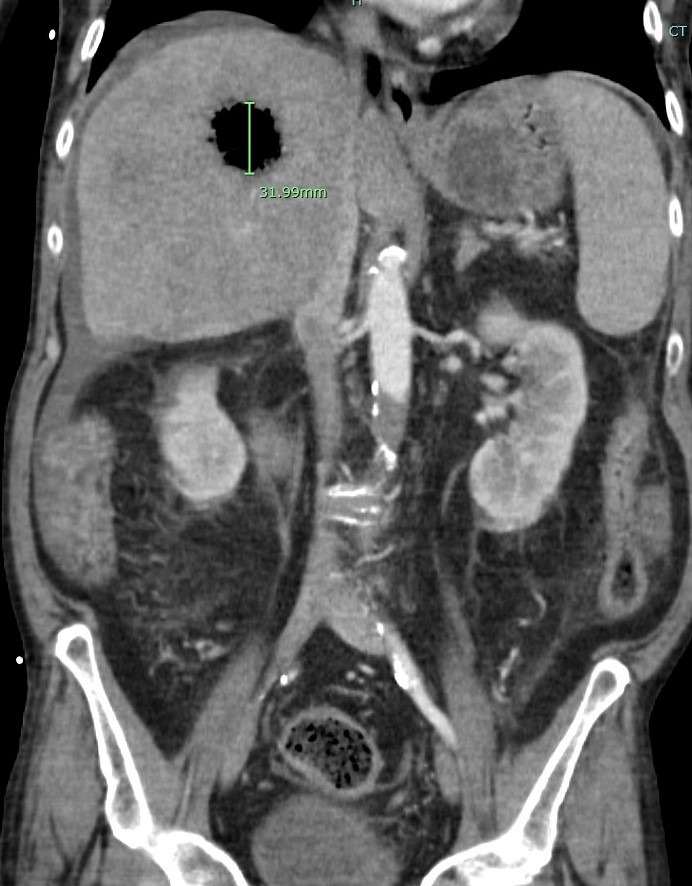Monday Poster Session
Category: Liver
P2548 - Lethal Invasion: Clostridium Perfringens Pyogenic Liver Abscess Causing Massive Intravascular Hemolysis and Septic Shock
Monday, October 23, 2023
10:30 AM - 4:15 PM PT
Location: Exhibit Hall

.jpeg.jpg)
Mohammad A. Ahmed-Khan, MD
Danbury Hospital - Yale School of Medicine
Danbury, CT
Presenting Author(s)
Award: Presidential Poster Award
Mohammad A. Ahmed-Khan, MD1, Felipe Carmona Pires, MD2, Nisha Nepal, MD2, Mahnoor Hanif, MD3, Zakee Jiffry, MD2, Danielle Gratza, BS4
1Danbury Hospital - Yale School of Medicine, Danbury, CT; 2Danbury Hospital, Danbury, CT; 3CMH Lahore Medical College, Lahore, Punjab, Pakistan; 4Ross School of Medicine, Danbury, CT
Introduction: Clostridium perfringens is a gram-positive spore forming anaerobic bacteria capable of causing a variety of pathology including liver abscesses with an incidence of 2-3 per 100,000. Bacteremia from C perfringens is exceedingly rare and can present with the development of pyogenic liver abscesses and massive intravascular hemolysis that can be rapidly fatal if not treated promptly and aggressively reported rates of mortality are >70%.
Case Description/Methods: A 70-year-old male with a history of cirrhosis, hypertension, hyperlipidemia, presented to the ED with fever and weakness. Vital signs showed patient was febrile to 39.5C, hypotensive: SBPs in the 80-90s, on admission the patient's Hb was 12.3 g/dL on repeat in the PM the patient's hemoglobin dropped to 6.5 g/dL with a WBC count of 17.6 x 109/uL. LFTs: Bilirubin Total 1.7 mg/dL, Direct 0.6 mg/dL, AP 193 U/L, GGT 203 U/L, ALT 133 U/L, AST 223 U/L; repeat LFTs showed a Bilirubin 22.0 mg/dL and Direct 3.5 mg/dL, ALT 1665 U/L and AST >7000 U/L and AP 175 U/L. Blood cultures were positive for C perfringens. CT scan showed a gas-containing lesion in segment 8 of the liver with surrounding edema.
Due to septic shock he developed ATN and was treated for both acute renal failure and C. perfringens bacteremia in the ICU. Patient ultimately required a 2-month course of IV Piperacillin/Tazobactam with improvement in clinical status; he was discharged to acute rehab. At time of discharge the patient's LFTs normalized with the exception of AP which was persistently elevated in the 140s U/L.
Discussion: C. perfringens infection is an uncommon entity and presenting with liver abscesses are very rare and rapidly fatal. The primary virulence factor is its α-toxin (lecithinase) which decomposes phospholipids and cell membranes leading to cell lysis. When the bacteria enters the bloodstream it triggers massive intravascular hemolysis by the same mechanism, this was demonstrated by the rapid drop in our patient's hemoglobin over the course of a day. The bacterium can infect the liver through various routes such as hematogenous, direct extension from an adjacent focus, or the result of trauma/surgery. Early identification of infection is difficult due to the nonspecific nature of presentation however it is imperative that it be identified rapidly. Any clinician should keep a high index of suspicion and high risk patients presenting with fever, unexplained hemolysis and positive blood cultures for gram-positive rods.

Disclosures:
Mohammad A. Ahmed-Khan, MD1, Felipe Carmona Pires, MD2, Nisha Nepal, MD2, Mahnoor Hanif, MD3, Zakee Jiffry, MD2, Danielle Gratza, BS4. P2548 - Lethal Invasion: Clostridium Perfringens Pyogenic Liver Abscess Causing Massive Intravascular Hemolysis and Septic Shock, ACG 2023 Annual Scientific Meeting Abstracts. Vancouver, BC, Canada: American College of Gastroenterology.
Mohammad A. Ahmed-Khan, MD1, Felipe Carmona Pires, MD2, Nisha Nepal, MD2, Mahnoor Hanif, MD3, Zakee Jiffry, MD2, Danielle Gratza, BS4
1Danbury Hospital - Yale School of Medicine, Danbury, CT; 2Danbury Hospital, Danbury, CT; 3CMH Lahore Medical College, Lahore, Punjab, Pakistan; 4Ross School of Medicine, Danbury, CT
Introduction: Clostridium perfringens is a gram-positive spore forming anaerobic bacteria capable of causing a variety of pathology including liver abscesses with an incidence of 2-3 per 100,000. Bacteremia from C perfringens is exceedingly rare and can present with the development of pyogenic liver abscesses and massive intravascular hemolysis that can be rapidly fatal if not treated promptly and aggressively reported rates of mortality are >70%.
Case Description/Methods: A 70-year-old male with a history of cirrhosis, hypertension, hyperlipidemia, presented to the ED with fever and weakness. Vital signs showed patient was febrile to 39.5C, hypotensive: SBPs in the 80-90s, on admission the patient's Hb was 12.3 g/dL on repeat in the PM the patient's hemoglobin dropped to 6.5 g/dL with a WBC count of 17.6 x 109/uL. LFTs: Bilirubin Total 1.7 mg/dL, Direct 0.6 mg/dL, AP 193 U/L, GGT 203 U/L, ALT 133 U/L, AST 223 U/L; repeat LFTs showed a Bilirubin 22.0 mg/dL and Direct 3.5 mg/dL, ALT 1665 U/L and AST >7000 U/L and AP 175 U/L. Blood cultures were positive for C perfringens. CT scan showed a gas-containing lesion in segment 8 of the liver with surrounding edema.
Due to septic shock he developed ATN and was treated for both acute renal failure and C. perfringens bacteremia in the ICU. Patient ultimately required a 2-month course of IV Piperacillin/Tazobactam with improvement in clinical status; he was discharged to acute rehab. At time of discharge the patient's LFTs normalized with the exception of AP which was persistently elevated in the 140s U/L.
Discussion: C. perfringens infection is an uncommon entity and presenting with liver abscesses are very rare and rapidly fatal. The primary virulence factor is its α-toxin (lecithinase) which decomposes phospholipids and cell membranes leading to cell lysis. When the bacteria enters the bloodstream it triggers massive intravascular hemolysis by the same mechanism, this was demonstrated by the rapid drop in our patient's hemoglobin over the course of a day. The bacterium can infect the liver through various routes such as hematogenous, direct extension from an adjacent focus, or the result of trauma/surgery. Early identification of infection is difficult due to the nonspecific nature of presentation however it is imperative that it be identified rapidly. Any clinician should keep a high index of suspicion and high risk patients presenting with fever, unexplained hemolysis and positive blood cultures for gram-positive rods.

Figure: Focal roughly 2.8 x 3.2 x 3.2 cm gas-containing lesion within segment 8 of the liver with subtle surrounding edema. Primary diagnostic consideration is a hepatic abscess.
Disclosures:
Mohammad Ahmed-Khan indicated no relevant financial relationships.
Felipe Carmona Pires indicated no relevant financial relationships.
Nisha Nepal indicated no relevant financial relationships.
Mahnoor Hanif indicated no relevant financial relationships.
Zakee Jiffry indicated no relevant financial relationships.
Danielle Gratza indicated no relevant financial relationships.
Mohammad A. Ahmed-Khan, MD1, Felipe Carmona Pires, MD2, Nisha Nepal, MD2, Mahnoor Hanif, MD3, Zakee Jiffry, MD2, Danielle Gratza, BS4. P2548 - Lethal Invasion: Clostridium Perfringens Pyogenic Liver Abscess Causing Massive Intravascular Hemolysis and Septic Shock, ACG 2023 Annual Scientific Meeting Abstracts. Vancouver, BC, Canada: American College of Gastroenterology.

